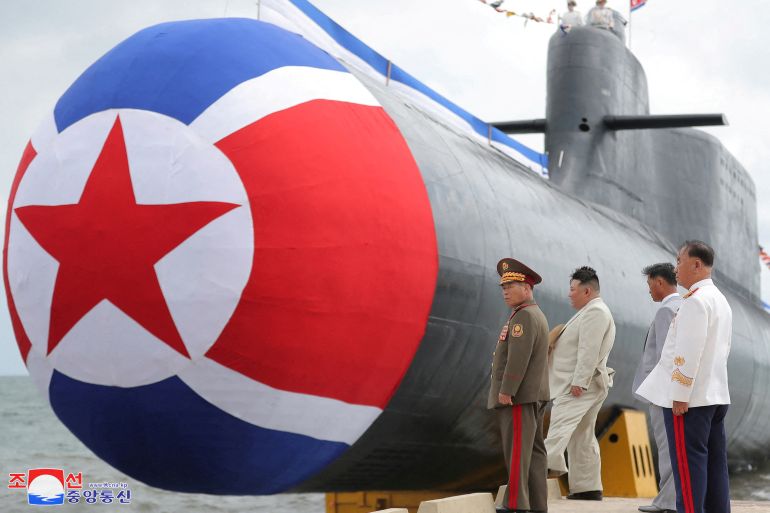All you need to know about North Korea’s new nuclear-armed submarine
The Hero Kim Kun Ok is evidence of Pyongyang’s determination to modernise and upgrade its submarine fleet.

North Korea has launched its latest submarine, with the ceremony attended by leader Kim Jong Un.
The Sinpo-C class submarine is the latest and most potent addition to North Korea’s nuclear arsenal.
Keep reading
list of 4 itemsTop Chinese officials to join North Korea founding celebrations
North Korea would pay ‘price’ if it supplies Russia with weapons, US says
North Korean leader Kim expected to meet Russia’s Putin: US
A modified Russian design, it uses a diesel engine that can in turn charge a series of batteries, allowing the submarine to run virtually silent when needed. Diesel-electric propulsion is a decades-old technology, but North Korea has radically altered the design, stretching the sail to include some missile launch tubes.
Analysis of the photos of this new submarine, named Hero Kim Kun Ok, suggests it can silently transport and launch 10 Pukguksong-3 missiles while still submerged.
This is a huge leap in capabilities for North Korea.
Long-range missiles launched from land would be quickly spotted and tracked as anti-missile batteries were alerted. However, this new submarine would, in theory, be able to travel underwater, closing in stealthily on its target. The closer the sub could get, the less distance is needed for the missile to travel to its target, giving very little time for the target to react and defend itself.
North Korea already has the ability to attack its neighbour South Korea from mobile launch sites on land, with little chance of them all being intercepted. This submarine gives North Korea a region-wide offensive capability it did not possess before and is designed to take the fight to potential adversaries in the Pacific, such as Japan or United States’ bases as far away as Guam.
The missile itself is solid-fuelled and has a range of 1,900km. Also, the angle from which submarine-launched ballistic missiles (SLBMs) are launched could be an issue for anti-ballistic missile systems, like the Terminal High Altitude Area Defence system (THAAD). THAAD is designed to intercept and destroy ballistic missiles during their final phase of flight and was deployed to South Korea in 2017.
The launch angle, time in the air and distance to target all make the Pukguksong-3 a powerful addition to the country’s arsenal, able to deliver a nuclear warhead anywhere within range, with little to no warning.
An earlier version, the Gorae-class submarine, has not seen extensive trialling, leading analysts to conclude the modifications were a failure. Still, while only able to launch one missile of much shorter range, this earlier sub served as a testbed for ideas that have come to fruition in this latest Sinpo-C design.
South Korea already has a more advanced diesel-electric vessel and has been regularly testing and upgrading its SLBMs, but this is the first time that North Korea will be able to match them, and the Hero Kim Kun Ok’s addition to North Korea’s navy will no doubt complicate South Korean strategic thinking.
Japan, too, will now likely focus on developing its own range of missile subs, further accelerating the region’s ongoing arms race.
Looking to Russia, North Korea has realised that a nuclear-capable navy, especially a nuclear-capable submarine fleet, is a powerful way to offset any strategic weakness the country may possess. There are reports that when President Vladimir Putin and Kim Jong Un meet in Vladivostok there will be a request for Russian nuclear propulsion technology in exchange for the large amounts of ammunition and arms Putin needs desperately for his continuing war in Ukraine.
All signs indicate that North Korea now intends to modernise and expand its missile submarine fleet.